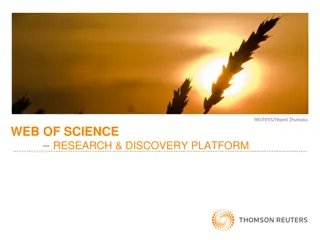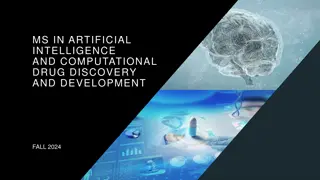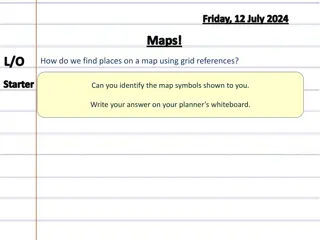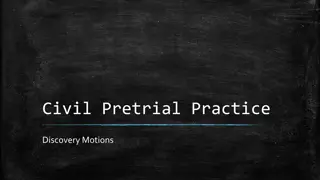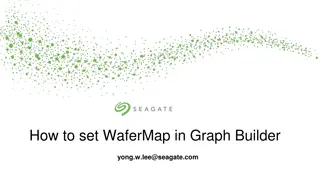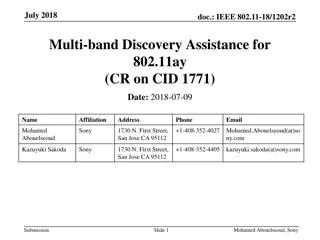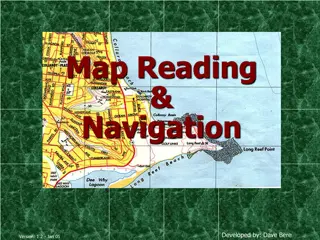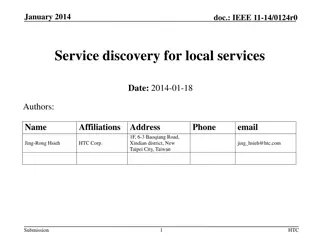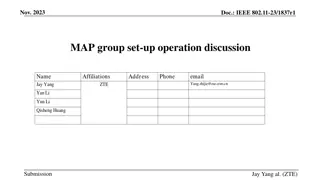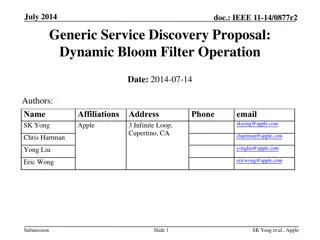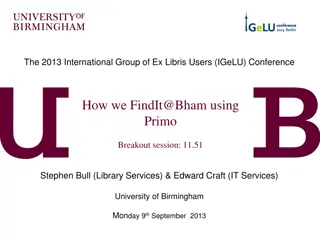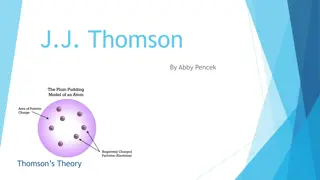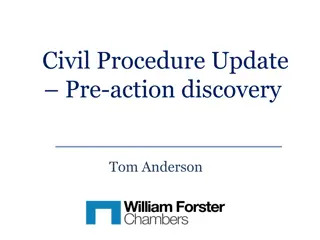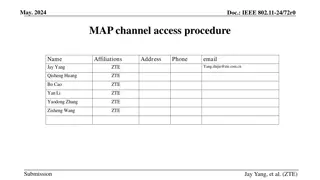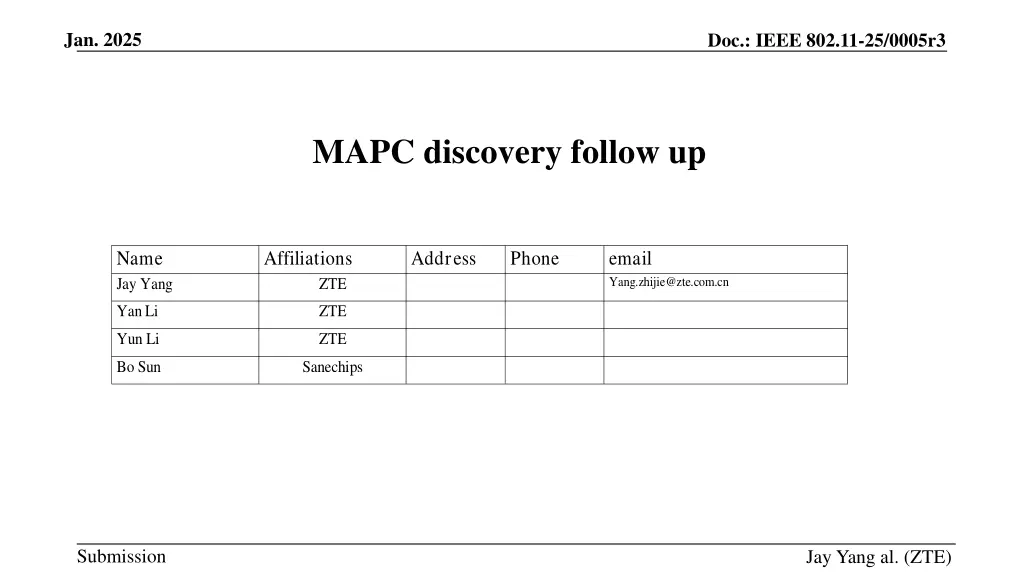
Trigger-Based MAPC Discovery Procedure for IEEE 802.11-25 Standard
In this document for IEEE 802.11-25, Jay Yang from ZTE proposes a Trigger-Based MAPC Discovery Procedure to address overhead issues in M-AP discovery. The procedure aims to optimize AP interaction by leveraging RA-RU and includes merge options for efficiency. Explore the key aspects and proposed solutions outlined in the submission slides.
Download Presentation

Please find below an Image/Link to download the presentation.
The content on the website is provided AS IS for your information and personal use only. It may not be sold, licensed, or shared on other websites without obtaining consent from the author. If you encounter any issues during the download, it is possible that the publisher has removed the file from their server.
You are allowed to download the files provided on this website for personal or commercial use, subject to the condition that they are used lawfully. All files are the property of their respective owners.
The content on the website is provided AS IS for your information and personal use only. It may not be sold, licensed, or shared on other websites without obtaining consent from the author.
E N D
Presentation Transcript
Jan. 2025 Doc.: IEEE 802.11-25/0005r3 MAPC discovery follow up Name Jay Yang Affiliations Address Phone email Yang.zhijie@zte.com.cn ZTE YanLi ZTE Yun Li ZTE Bo Sun Sanechips Submission Jay Yang al. (ZTE)
Jan. 2025 Doc.: IEEE 802.11-25/0005r3 Introduction 11bn group agreed on the action frame for MAPC Discovery and the UHR AP is capable of transmitting a TB PPDU with the following motion: A UHR AP shall indicate to another AP its capability to respond in a TB PPDU or not[M #120] When an AP use Management frames to discover the capabilities and/or parameters of individual M-AP coordination schemes, the AP shall use the defined MAPC Public Action frame with the following setting:[M#359] The action field is set to MAPC Discovery In this contribution, we propose to define a TB MAPC Discovery procedure Submission Slide 2 Jay Yang, et al. (ZTE)
Jan. 2025 Doc.: IEEE 802.11-25/0005r3 The overhead issue in M-AP discovery procedure In MAPC, one AP may discover another AP via the MAPC discovery action frame exchange. In active scan, one AP may send broadcast discovery request frame, and receives the discovery response frame one by one in different TXOPs, in which a serious overhead issue may happen Submission Slide 3 Jay Yang, et al. (ZTE)
Jan. 2025 The following figure depicts the overhead issue in actively discovery procedure Doc.: IEEE 802.11-25/0005r3 TXOP1 TXOP2 TXOP5 discovery response TXOP3 discovery response TXOP4 discovery response discovery response discovery request T AP1 AP2 AP3 AP4 AP5 Submission Slide 4 Jay Yang, et al. (ZTE)
Jan. 2025 Doc.: IEEE 802.11-25/0005r3 Propose to define Trigger-based MAPC discovery procedure To mitigate the overhead issue, we propose to define a Trigger-based MAPC discovery procedure. Leverage the gain of RA-RU, the initiating AP may transmit a TB frame including multiple RA-RU for the responding AP without AP ID. Other aspects for TB MAPC discovery The responding APs that don t support the transmission of TB PPDU won t make the response. Also, AID12 field can be set to the AP ID if the target responding AP obtained an AP ID from the initiating AP before. MAPC discovery request and TB frame can be merged to one frame(like reusing TRS control field or define a new MAPC discovery request polling frame(DRP)). Submission Slide 5 Jay Yang, et al. (ZTE)
Jan. 2025 Doc.: IEEE 802.11-25/0005r3 The following figure depicts one approach of Trigger Based MPAC discovery request/response procedure(RU size=242-tone) Note: RU size in DRP may smaller or larger than 242-tone Submission Slide 6 Jay Yang, et al. (ZTE)
Jan. 2025 Doc.: IEEE 802.11-25/0005r3 Additional thought on the capability of sharing/shared AP In general, each AP is capable to become a sharing or a shared AP during MAPC transmission. E.g. each AP can allocate an AP ID to its peer AP during MPAC negotiation phase. And each AP can share a portion of the TXOP to its peer AP in Co-TDMA scheme. But in some special use case, like MAPC between a master AP and a slave AP in a centralized network. The master AP with higher capability may always be a sharing AP(TXOP owner during MAPC transmission), and the slave APs with lower capability may always be a shared AP. In another cases, MAPC may be between the regular AP and the mobile AP. The regular AP may always being a sharing AP,especially for these APs lack of supporting the transmission of TB PPDU. The mobile AP may always being a shared AP due to low capability, but it can transmit TB PPDU as it s the basic requirement for the STA in 11ax. Slide 7 Submission Jay Yang, et al. (ZTE)
Jan. 2025 Doc.: IEEE 802.11-25/0005r3 The proposal of sharing/shared AP capability in MAPC discovery procedure To meet different requirements, we propose to add the sharing/shared AP capability indication for Co-TDMA,Co-SR and Co-BF in MAPC discovery action frame. Using totally 6 bits to indicate the sharing/shared AP capability for Co-TDMA, Co-SR and Co-BF. In MAPC agreement negotiation, the MAPC requesting AP and the responding AP decide whether to allocate an AP ID based on the sharing/shared AP capability of the three schemes. Submission Slide 8 Jay Yang, et al. (ZTE)
Jan. 2025 Doc.: IEEE 802.11-25/0005r3 Summary Analysis some special use cases for the requirement of sharing/shared AP capability Propose to define a TB discovery request/response frame exchange to avoid overhead issue. Only the responding APs that are capable of transmitting TB PPDU can make the response. AID12 field in the Trigger frame can set to RA-RU or set to the responding AP s AP ID Propose to define the sharing/shared AP capability indication for Co- TDMA,Co-SR and Co-BF. Such capability indication is included in MAPC discovery action frame. Totally 6 bits for now. Submission Slide 9 Jay Yang, et al. (ZTE)
Jan. 2025 Doc.: IEEE 802.11-25/0005r3 THANK YOU Submission
Jan. 2025 Doc.: IEEE 802.11-25/0005r3 Reference 24/209r6 24/1762r13 PDT-MAC-NPCA TGbn Specification Framework for TGbn Submission Slide 11 Jay Yang, et al. (ZTE)
Jan. 2025 Doc.: IEEE 802.11-25/0005r3 SP1 Do you agree to define Trigger based MAPC discovery procedure? Submission Slide 12 Jay Yang, et al. (ZTE)
Jan. 2025 Doc.: IEEE 802.11-25/0005r3 SP2 Do you agree to define the capability indication of sharing/shared AP in Co-TDMA,Co-SR and Co-BF scheme in MAPC discovery frame? Submission Slide 13 Jay Yang, et al. (ZTE)

